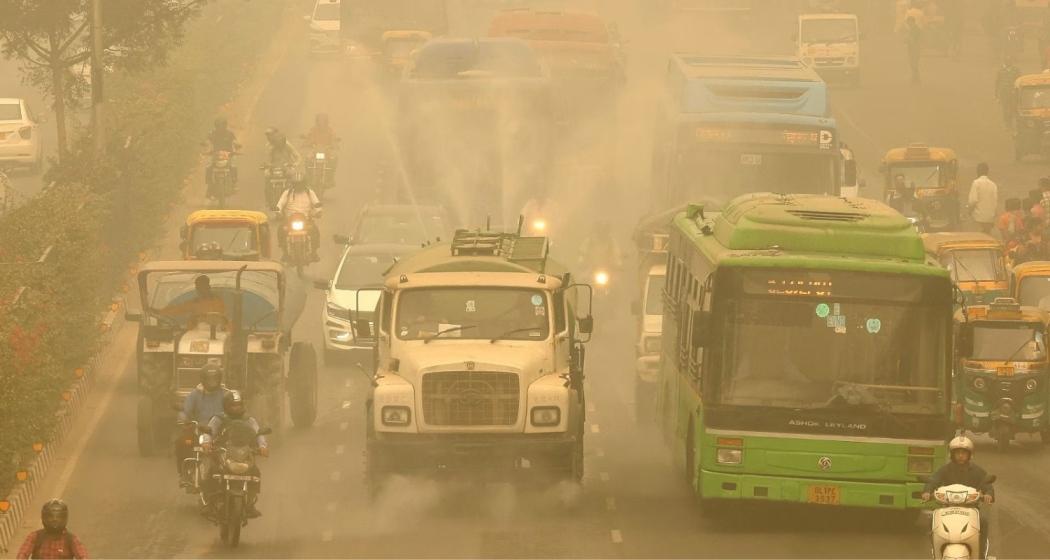Trending:
National Capital or a smoke chamber?
Delhi’s air quality hits hazardous levels post-Diwali, sparking outrage as green crackers fail to curb pollution and systemic inaction persists.News Arena Network - New Delhi - UPDATED: October 24, 2025, 09:04 PM - 2 min read

Smog diffuser on the roads of New Delhi as smoke blankets the city.
The temperatures in the National Capital haven't descended down to winter levels yet, but the AQI has taken an ominous spike already. In the week up to Diwali, the air quality remained in the very poor category for days in a row and breached the 350 mark, making many rightfully question whether the compromised air quality will ever figure in the list of governance priorities.
As the NCR graduated from the no-cracker rule to ‘green cracker’ rule, the residents woke up to a toxic haze and air quality hitting the 360 mark on the morning after Diwali.
The developments in the past week have made environmental activists sit up, take note and question as to what’s worse—the fact that ‘cracker ban’ has never been successfully and strictly implemented till date or the Supreme Court caving into political pressures and giving the go-ahead for less-polluting crackers?
Fire crackers, which had been banned in Delhi and suburbs since 2020, were lifted off the blanket ban with people being allowed to use ‘green or less polluting’ crackers. Any mass activities detrimental to public health, possibly highlight two aspects of a civilization—lack of awareness on the dangers of pollution or delusion that those dangers are not coming to harm them. According to several accounts listed by people on social media and journalists, traditional crackers were openly being sold too.
Ruthless measures need of the hour
After the Capital region was left gasping, former NITI Aayog CEO, Amitabh Kant took a dig at the top court and said, “The Supreme Court chose the right to burn crackers over the right to live and breathe.” Bringing forth a few suggestions to immediately tackle the problem, he urged the authorities to take a cue from cities like Los Angeles, Beijing and London, and suggested, “Ending the crop and biomass burning, shutting down thermal power plants and switching the entire transportation services to electric mode in the next five years.”
In the past week, the administration has invoked GRAP (Graded Response Action Plan) Stages, imposing restrictions on the use of diesel generators and burning of coal and firewood. GRAP Stage 1 was implemented on October 14, followed by Stage 2 on October 19. GRAP Stage 1, 2, 3 and 4 are invoked once the AQI crosses 200, 300, 400 and 450 mark, respectively. Last year, the Supreme Court had hit out at CAQM for lax implementation of GRAP and revised the Stage 4 threshold by reducing it to 400 from 450. Experts argue invoking graded response action plan is more of a symptomatic treatment, aimed at tiding through the winter months.
Steady, continuing deterioration
The Capital did not become a victim of severe air pollution overnight. It has taken years of negligence and politics to reach here. Between 2021-2024, Delhi’s air quality increasingly deteriorated and last year on November 18, the Capital became a living gas chamber with AQI touching a historical, record high of 700. A year down the line, nothing has improved, let alone change—neither the administration’s approach, nor the people’s outlook.
This year the air quality in Delhi once again garnered global attention after being listed as the world’s most polluted. According to the list shared by Swiss air quality firm IQAir this week, Delhi stood at the top, followed closely by Lahore, Karachi and Mumbai, which stood at 2nd, 4th and 5th place, respectively.
A look at the socials and online blogs clarify why Delhi residents might be resigned to fate rather than resolved to fight the systemic apathy. There are blogs on what can be done at a personal level to counter AQI, with plants, air purifiers and masks topping the list of recommendations.
“Why can’t people display the same level of activism that they showed a few weeks ago when the ruling came for stray dogs?” opine many. Among the handful of celebs, actor Richa Chadha lamented the state of affairs by sharing a video of people bursting crackers, “Heartbreaking to see the apathy and sheer hatred for oneselves. Politicians will do nothing unless we learn to speak up for ourselves."
Blame-game over solutions
For answers, the nation’s climate think-tank doesn't have to look very far or even further back in time. Not very long ago, Beijing was on its way to competing with Delhi in worse air quality before it ditched the myopic vision and planned ahead. The Chinese government imposed ultra-low emission standards, set up advanced air quality monitoring systems, built more public transport and took to aggressive campaigning.
A UN report in 2019 showed that in a span of just four years, between 2013 and 2017, fine particle levels in Beijing dropped by 35 per cent. “No other city or region on the planet has achieved such a feat,” said the report. Even though it was credited to measures and changes introduced and fine-tuned over the course of two decades.
Air pollution and discourse on air pollution remain a staple of Delhi’s winter now. The conversation and the problem remains the same, the solutions remain elusive and the government seems half-hearted and interim in fixing things. Do the people need to step up? Each year, the solutions to the issue remain overshadowed by the din of political noise and blame-game. Is it the stubble burning, the crackers, the vehicles? Eventually, it is the people and their lungs and it is time the residents realized that without relying on the administration.
